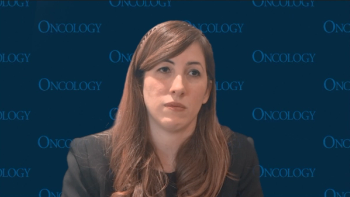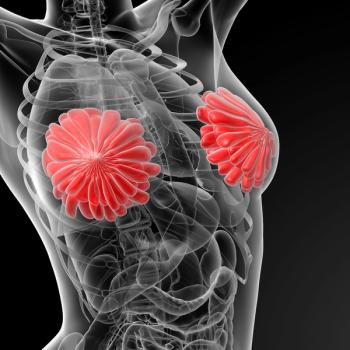
First-Line TKI Plus Up-Front Local Radiotherapy Improves Survival in EGFR+ NSCLC
Patients with EGFR-mutated non–small cell lung cancer had an improved survival benefit following treatment with a first-line tyrosine kinase inhibitors plus up-front local radiotherapy.
Adding up-front local radiotherapy to a first-line tyrosine kinase inhibitor (TKIs) improved progression-free survival (PFS) and overall survival (OS) in patients with EGFR-mutated non–small cell lung cancer, according to the results of the phase 3 SINADS trial (NCT02893332).
The pre-specified interim analysis found patients who were receiving only TKIs had a median PFS of 12.5 months (95% CI, 11.6-13.4) vs 20.2 months (95% CI, 17.9-22.5) for those receiving TKIs plus radiotherapy (HR, 0.22; 95% CI, 0.17-0.46; P <.001). The median OS for the TKI group was 17.6 months (95% CI, 15.4-19.8) vs 25.5 months (95% CI, 23.2-27.8) for the TKI plus radiotherapy group (HR, 0.44; 95% CI, 0.28-0.68; P <.001).
A total of 133 patients were randomized to either the TKI-only group (n = 65) or the TKI plus radiotherapy group (n = 68). Because of the results from this analysis, the ethics committee did not recommend additional recruitment for the trial. The cutoff for treatment was 1 year, and the median follow-up was 23.6 months.
In terms of patient characteristics, 73.1% of patients in the TKI group had bone metastases vs 68.9% in the TKI plus radiotherapy group. Other areas of oligometastatic lesions included the abdomen (18.8% vs 18.0%) and the contralateral lung (6.9% vs 9.6%). Ninety-two patients had an EGFR abnormality in exon 19. Additionally, investigators more commonly treated patients with gefitinib (52.6%) and erlotinib (39.8%) vs icotinib. The most common radiotherapy doses included 30 Gy in 53.5% of fields, and 25 Gy in 31.0% of fields.
In 36 patients in the TKI group vs 62 in the TKI plus radiotherapy, local control of primary tumor and metastases was achieved at the last follow-up (P <.001). The 6-month PFS rate was 95.2% (95% CI, 93.6%-96.9%) in the TKI group and 99.1% (95% CI, 98.7-99.5%) in the TKI plus radiotherapy group (P >.05).
At the time this analysis was conducted, 93 patients had died. Additionally, 38 patients in the TKI-only arm underwent palliative radiotherapy to manage symptoms, 6 of whom underwent radiofrequency ablation.
The post-hoc analysis identified several independent predictors of PFS, including Zurbod performance status (P = .02), number of metastases (P = .004), and radiotherapy (P = .005). Additionally, the independent factor of OS included Zubrod performance status (P = .02), T stage (P = .02), number of metastases (P = .004), mutation type (P = .001), and radiotherapy (P = .004).
Adverse effects relating to TKI treatment included skin reactions in both groups. Three patients in the TKI-only group and 5 in the TKI plus radiotherapy group required dose reductions, with 1 and 2 patients in both respective groups discontinuing treatment. Grade 3/4 skin toxicity was reported in 10 patients in the TKI group and 8 patients also developed grade 3/4 pruritus. Among those in the TKI plus radiotherapy group, 10 patients developed grade 3/4 skin rash, and 5 patients had grade 3/4 pneumonitis.
Moreover, 1 patient had a fractured rib that was attributed to chest radiotherapy. Two patients needed long-term pain management after receiving radiotherapy, with 1 patient having nephrolithiasis, and the other having herpes zoster that was deemed unrelated to treatment.
Reference
Wang XS, Bai YF, Verma V, et al. Randomized trial of first-line tyrosine kinase inhibitor with or without radiotherapy for synchronous oligometastatic EGFR-mutated NSCLC. J Natl Cancer Inst. Published Online January 30, 2022. doi:10.1093/jnci/djac015
Newsletter
Stay up to date on recent advances in the multidisciplinary approach to cancer.














































































